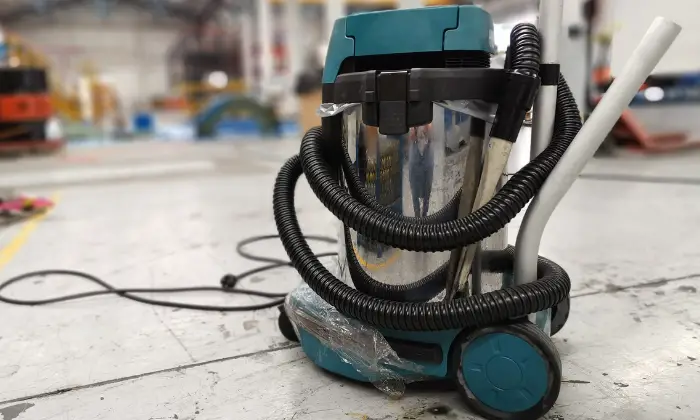
A Hydro Vacuum Cleaner, also known as a hydro-vac, is a powerful and efficient industrial cleaning tool that combines high-pressure water and suction to clean surfaces effectively and remove debris.
This article will dive deep into everything you need to know about what is Hydro Vacuum Cleaners, including how they have been used, applications, types and features, safety considerations, and maintenance.
By the end of this article – you will have a comprehensive understanding of this powerful cleaning tool and how it can benefit your business or industry.
Definition: what is hydro vacuum cleaner?
A hydro-vacuum cleaner, also known as a hydro-vac, is a type of industrial vacuum cleaner or appliance that utilizes a combination of water and suction to remove debris and clean surfaces. These machines are designed to loosen and wet the debris before it is vacuumed up, which can improve the cleaning process, making it efficient and effective.
It is a versatile and efficient alternative to traditional vacuum cleaners and pressure washers that is commonly used – in a wide range of industries, including construction, maintenance, and industrial cleaning.
The Hydrovac cleaning process offers several benefits that make it ideal for heavy-duty cleaning tasks and removing hazardous materials like asbestos or lead-based paint.
How it works:

- Hydro-vacuum cleaners use a combination of water and suction to clean surfaces and remove debris.
- Water is injected at high pressure to loosen and break up dirt, debris, and other contaminants on a surface.
- The water and debris are then immediately vacuumed into a holding tank.
- Benefits include increased efficiency and effectiveness and minimizing dust and debris from becoming airborne.
- They are commonly used in construction, maintenance, and industrial cleaning, beneficial for removing hazardous materials such as asbestos or lead-based paint.
- Different types are available for specific applications and industries, such as trailer-mounted, skid-mounted, and truck-mounted units.
- Features to consider when selecting a hydro-vacuum cleaner include power, suction, water flow rate, size of holding tank, type of hose and nozzle attachments, and portability.
- Proper training and safety protocols are essential to use it safely.
Applications:
Hydro-vacuum cleaners have a wide range of industrial and commercial applications. They are commonly used in the construction, maintenance, and industrial cleaning industries. They are particularly useful for removing heavy debris like mud, sand, and gravel, as well as for cleaning underground utilities, such as sewers and drainage systems, and for excavation projects.
Hydro-vacuum cleaners are also useful for removing hazardous materials such as asbestos or lead-based paint. They can be used to clean large industrial facilities, factories, warehouses, and commercial properties such as parking garages, airports, and shopping centers. They are also used in the oil and gas industry and in municipal services such as street cleaning and snow removal.
Types and Features:
Different types of hydro-vacuum cleaners available include:
- Trailer-mounted units: typically used for construction and maintenance.
- Skid-mounted units: commonly used in industrial cleaning and underground utility work.
- Truck-mounted units: these units are mounted on trucks; they are highly portable and can be taken to any location.
Key features to consider when selecting a hydro-vacuum cleaner include:
- Power: determines the unit’s cleaning capabilities.
- Suction and water flow rate: affect the efficiency and effectiveness of the cleaning process.
- Size of the holding tank: determines the amount of debris that can be collected before emptying.
- Type of hose and nozzle attachments: different types are available for different cleaning tasks.
- Portability: depending on the application, portability is important to move the unit from one location to another.
- Additional features: like remote control, automatic shut-off, filtration systems etc.
Safety Considerations:
- Hydro-vacuum cleaners are powerful and efficient cleaning tools, but they also require proper training and safety protocols to use safely.
- It is important to follow all relevant safety regulations & guidelines to minimize the risk of injury or accidents.
- Operators should be trained in the proper use of the equipment, including the use of protective gear such as goggles, respirators, and ear protection.
- It is also important – to be aware of the potential hazards of the materials being cleaned, such as hazardous chemicals or dangerous dust.
Maintenance and Upkeep
- Regular maintenance and upkeep are essential to ensure the hydro-vacuum cleaner is in good working condition and to extend its lifespan.
- It is important to follow the manufacturer’s recommended maintenance schedule, which may include regular inspections, cleaning, and lubrication.
- The holding tank should be emptied and cleaned regularly, and all filters and hoses should be checked for blockages and damage.
- It is important to store the unit in a clean and dry place when not in use to protect it from damage and to extend the life of the unit.
- Maintaining maintenance and repair records is important to ensure the unit is in good working condition and to maintain compliance with safety regulations.
Comparison of different types of hydro vacuums
Different types of hydro-vacuum cleaners have different features and capabilities that make them suitable for specific applications and industries.
- Trailer-mounted units are typically used for construction and maintenance. They are designed to be towed behind a truck and can be easily transported to different job sites. They are typically smaller and less powerful than other types of hydro-vacuum cleaners, but they are also more manoeuvrable and can access tight spaces.
- Skid-mounted units are commonly used in industrial cleaning and underground utility work. They are designed to be mounted on a skid or platform, which makes them more stable and allows for easy transport on a flatbed truck. They are typically more powerful and have larger holding tanks than trailer-mounted units, which makes them more suitable for heavy-duty cleaning tasks.
- Truck-mounted units are mounted on trucks (Hydro Excavation Truck); they are highly portable and can be taken to any location. They are typically the most powerful and have the largest holding tanks of all types of hydro-vacuum cleaners. They are ideal for large-scale industrial cleaning and hazardous material removal.
Ultimately, the choice of a hydro-vacuum cleaner will depend on the specific cleaning requirements and the type of industry it will be used in.
Frequently Asked Questions
Q: What is a vacuum excavator used for?
A vacuum excavator is a type of industrial equipment used for digging, potholing and underground utility location. It uses a high-powered vacuum to suction soil and debris while simultaneously disposing of it in a debris tank.
It is commonly used for hydro excavation around underground utilities, such as gas and water lines, without damaging them. It is also used for potholing, which is the process of exposing underground utilities for inspection or repair, and for slot trenching, which is a method of excavating a narrow trench with minimal surface disruption.
Additionally, vacuum excavators are often used for cleaning and removing debris in construction and industrial settings.
Q: What is a hydro-vac Tech?
A hydro-vac Tech is a professional who uses hydro-vac technology to clean large structures, like buildings and other large structures. Hydrovac Technology is a type of water jetting that uses high suction power and liquid spill to remove dirt, debris, and stains from surfaces.
A hydro-vac Tech typically uses a handheld vacuum cleaner to clean surfaces. A hydrovac Tech typically charges an hourly rate for their services.
Q: What is a vacuum excavator used for?
A vacuum excavator removes soil, gravel, and other debris from construction sites, mines, and other locations. It can be operated by one or two people and uses a water jet to remove dirt, rocks, and other materials.
Q: How does Hydrovac work?
A vacuum cleaner that uses hydropower is called a Hydrovac. The vacuum cleaner utilizes a water/hot water tank to create a high-pressure stream that sucks dirt and debris into the machine.
The water tank can be emptied using the hose and port on the side of the machine. Hydrovac can be used on hardwood floors, tiles, and carpets.
Q: How deep can you hydro excavate?
Hydro excavators can hydro excavate a range of depths, depending on the type of soil being excavated. Generally, hydro excavators are able to hydro excavate up to a depth of 50 feet. For excavation deeper than 50 feet, a backhoe may be used in addition to the hydro excavator.
Q: What is the need for vacuum excavation?
The need for vacuum excavation can be explained through its various applications. Here are a few: – Construction: Vacuum excavation is used to remove earth, rock, and other material during construction projects.
This is done to make way for new buildings, roads, and other infrastructure. – Infrastructure: Vacuum excavation is also used in the construction of large water networks, bridges, and other large structures. – Mining: Vacuum excavation is also used in mining operations to excavate precious minerals.
Conclusion
When looking to clean up a large area, you can’t beat the power and versatility of a hydro-vacuum cleaner. With the right amount of water, these machines can clean up dirt, gravel, and even large rocks and trees—all while picking up smaller particles along the way.
If you’re interested in learning more about hydro-vacuums and how they impact your day-to-day life, we’ve got an ebook for you! It was written by our very own expert author, Shweta Chhajer. Download it today!





